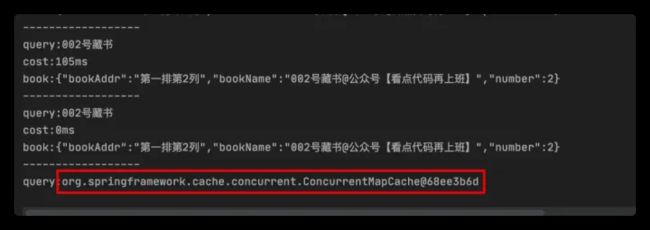学习之-Spring Cache缓存框架应用本地缓存
此文章用于个人学习记录,原文地址:https://zhuanlan.zhihu.com/p/452315531
如果想了解springCache与redis的交互请看其他文章
缓存是web项目不可或缺的一部分,通过缓存能够降低服务器数据库压力,提高服务器的稳定性及响应速度。
Spring Cache介绍
spring cache是spring框架自带的一套缓存框架。是Spring 提供的一整套的缓存解决方案,它不是具体的缓存实现,它只提供一整套的接口和代码规范、配置、注解等,用于整合各种缓存方案,比如Caffeine、Guava Cache、Ehcache。
Spring Cache并不是缓存的实现,而是缓存使用的一种方式,其基于注解和Spring高级特性提供缓存读写以及失效刷新等各种能力。
Spring Cache默认支持几个缓存实现,如下图jar包(spring-context-support 5.3.14版本)所示:
EhCache:纯Java进程内缓存框架,也是Hibernate、MyBatis默认的缓存提供。
Caffeine:使用Java8对Guava缓存的重写版本,从Spring5开始,Spring默认删除了Guava而使用Caffeine,支持多种缓存过期策略。
jcache:实现了JSR107规范的三方缓存都可以通过此包得到适配。
Spring Cache使用入门
Spring Cache依赖Spring的天然优势——AOP,我们只需要显式地在代码中调用第三方接口,在方法上加上注解,就可以实现把获取到的结果后把结果插入缓存内,在下一次查询的时候优先从缓存中读取数据。
使用Spring Cache也比较简单,简单总结就是3步:加依赖,开启缓存、加注解。
一、加依赖
maven:
org.springframework.boot
spring-boot-starter-cache
gradle:
implementation 'org.springframework.boot:spring-boot-starter-cache'二、开启缓存
需要在启动类加上@EnableCaching注解才能启动使用Spring Cache,比如:
package com.tin.example;
import com.tin.example.service.MyGuavaCacheService;
import com.tin.example.service.SpringCacheService;
import com.tin.example.util.SpringContextUtil;
import org.slf4j.Logger;
import org.slf4j.LoggerFactory;
import org.springframework.boot.SpringApplication;
import org.springframework.boot.autoconfigure.SpringBootApplication;
import org.springframework.cache.annotation.EnableCaching;
/**
* title: Application
*
* description:
*
* @author tin @【看点代码再上班】 on 2021/12/25 上午10:27
*/
@SpringBootApplication
@EnableCaching
public class Application {
private static final Logger LOGGER = LoggerFactory.getLogger(Application.class);
public static void main(String[] args) {
SpringApplication.run(Application.class, args);
LOGGER.info("容器启动成功... ");
SpringCacheService springCacheService = SpringContextUtil.getBean(SpringCacheService.class);
springCacheService.query();
// MyGuavaCacheService myGuavaCacheService = SpringContextUtil.getBean(MyGuavaCacheService.class);
// myGuavaCacheService.query();
}
}
三、加注解
在需要缓存返回结果的方法上加上注解@Cacheable即可,比如:
接入Caffeine缓存实现框架
上文讲到了Spring Cache支持三种缓存实现,在使用我们上面所说"三步"引入使用Spring Cache,我们究竟使用的是哪种缓存实现呢?
通过CacheManager打印看一下:
ConcurrentMapCache是Spring 内置默认的缓存实现。如果需要使用CaffeineCache,需要额外引入CaffeineCache包,同时生成一个CaffeineCacheManager的bean。
maven依赖:
CaffeineCacheManager生成:
package com.tin.example.caffeine;
import com.github.benmanes.caffeine.cache.Caffeine;
import org.springframework.cache.CacheManager;
import org.springframework.cache.caffeine.CaffeineCacheManager;
import org.springframework.context.annotation.Bean;
import org.springframework.context.annotation.Configuration;
import java.util.concurrent.TimeUnit;
/**
* title: CaffeineCacheConfig
*
* description:
*
* @author on 2021/12/26 下午2:47
*/
@Configuration
public class CaffeineCacheConfig {
@Bean
public CacheManager cacheManager() {
CaffeineCacheManager cacheManager = new CaffeineCacheManager();
cacheManager.setCaffeine(Caffeine.newBuilder()
.expireAfterWrite(10, TimeUnit.MINUTES)
.initialCapacity(100)
.maximumSize(10000))
;
return cacheManager;
}
}
配置完成后再运行就是这样的结果了:
常用注解
Spring Cache比较常用的几个注解:@Cacheable、 @CacheConfig、@CacheEvict、@CachePut、@Caching、@EnableCaching。spring-context依赖包下也能看到注解的定义。
除了CacheConfig只能用于类上,其余的都可以用在类或者方法上,用在方法上好理解,缓存方法结果,如果用在类上,就相当于对该类的所有可以缓存的方法(需要是public方法)加上注解。
@Cacheable
@Cacheble注解表示这个方法的结果可以被缓存,调用该方法前,会先检查对应的缓存key在缓存中是否已经有值,如果有就直接返回,不调用方法,如果没有,就会调用方法,同时把结果缓存起来。
@CacheConfig
有些配置可能又是一个类通用的,这种情况就可以使用@CacheConfig了,它是一个类级别的注解,可以在类级别上配置cacheNames、keyGenerator、cacheManager、cacheResolver等。
@CachePut
@CachePut注解修饰的方法,会把方法的返回值put到缓存里面缓存起来,它只是触发put的动作,和@Cacheable不同,不会读取缓存,put到缓存的值进程内其他场景的使用者就可以使用了。
@CacheEvict
@CacheEvict注解修饰的方法,会触发缓存的evict操作,清空缓存中指定key的值。
@Caching
@Caching能够支持多个缓存注解生效。





